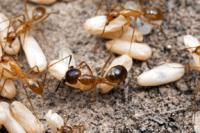
Desert carpetner ants store excess fat and pass it to colony members through lipid-rich oral secretions or unfertilized eggs.In a fascinating new study from the September/October 2006 issue of Physiological and Biochemical Zoology, Daniel A. Hahn (University of Florida) explores the ability of ants to store excess fat and pass it to colony members through lipid-rich oral secretions or unfertilized eggs. For perennial organisms, such as ant colonies, investing heavily in nutrient stores when food availability is high is a potential bet-hedging strategy for dealing with times of famine.
"Understanding the regulation of nutrient reserves, particularly fat storage, at the individual and colony levels is critical to understanding both the division of labor characteristics of social insect colonies and the evolution of important colony life-history traits such as the timing of reproduction, founding mode, and over-wintering behaviour," explains Hahn.__IMAGE_2
In order to better understand how individual fat storage tactics translated into colony-level resources, Hahn captured queens of different species and reared colonies under controlled laboratory conditions in nests for two years, feeding the ants a combination of frozen cockroach and moth eggs, mixed with honey, vitamins, and salt. He then sampled five colonies each of the two different species, and found that, despite similar environments, darker workers and soldiers stored more fat per unit of lean mass than lighter ants did, but the lighter colony involved a greater proportion of soldiers in storage.
"Storing more fat per unit lean mass has been well documented as a tactic for increasing fat storage during ontogeny among colonies of a number of ant species, and now has been shown to contribute to between-species differences as well," Hahn writes. "Differences in individual-level storage tactics between the two desert species could lead to significant behavioral differences, perhaps in the rate that individuals progress through behavioral development, or in their motivation to forage or defend their nests."
Source : University of Chicago Press Journals
 Print Article
Print Article Mail to a Friend
Mail to a Friend
